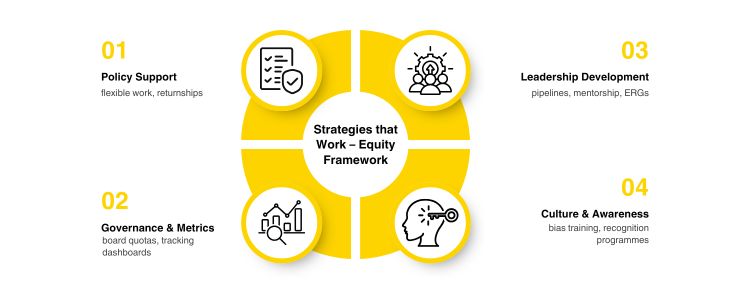
When the data scientist Asha at the Mumbai-based Global Capability Centre (GCC) joined the company’s board last year, it was just more than a personal achievement. This was a sign of a basic change. The GCCs of India, which began as cost-saving operations, are now becoming strategic capacity centers where boardroom equity is an important asset. India is a major power in the global GCC scenario, where about 1,900 centers provide employment to up to 1.9 million professionals. This scale makes India the world’s largest GCC center. Although progress is being made, the boardroom diversity progress is still yet to work. In listed Indian companies, about 21% of board seats are with women; this number has increased further than the regulatory requirement of a female director.
In major technical centers like Bengaluru, Pune, Hyderabad and Chennai, GCC has set goals for the representation of women at senior levels. They are also starting new initiatives such as the Returns Program and Sponsoring Track to help women in mid-career roles. Government policy and corporate diversity commitment are both helping to convert representation into a real, pipeline-manual process by a formality.
2025: The major GCCs will also have a voluntary 30% equity target on boards and more transparent dashboards to monitor their progress. 2026-27: Mid-tier GCCs are expected to expand their programmes on women leadership, which will serve to bridge the gap of the so-called leaky pipeline at the mid-management level. 2028: These pipeline projects will see the proportion of women in GCC leadership rise beyond 20-25%. 2030: India will be an international leader in corporate governance diversity, with multiple GCC centers reaching or surpassing the 30 per cent boardroom equity target.
Boardroom equity is not only an ethical option, it is also an economic option. Increased gender diversity has been associated with better decision-making and increased chances of outperforming financially. In the case of GCCs in India, fair boards bring in improved talent, higher quality contracts with their global parent companies and greater ESG credibility, which is being increasingly valued among investors.
The 30% Club is a vision of the GCCs in India. GCCs can transform boardroom equity into a source of competitive advantage resulting in innovation, economic value, and global leadership by investing in talent pipelines, sponsorship, and transformative metrics of governance. Now it falls upon the GCC CEOs, parent-company boards, and policymakers to speed up this process and turn representation into actual influence and sustainable growth.
A GDC refers to a single-minded offshore deployment, which provides proficient business, technology and operational services to corporate bodies on a global basis. BFSI, IT services, healthcare, telecom, retail, manufacturing, and other upcoming technologies, including AI and blockchain. They do not only target cost savings but now aim at innovation, automation, R&D, digital transformation, and high-value consulting. They design and create cloud, artificial intelligence, analytics, cloud security, and process automation. A large supply of STEM graduates, multilingual workers and niche skills in AI, ML, cloud, and analytics. Aditi, with a strong background in forensic science and biotechnology, brings an innovative scientific perspective to her work. Her expertise spans research, analytics, and strategic advisory in consulting and GCC environments. She has published numerous research papers and articles. A versatile writer in both technical and creative domains, Aditi excels at translating complex subjects into compelling insights. Which she aligns seamlessly with consulting, advisory domain, and GCC operations. Her ability to bridge science, business, and storytelling positions her as a strategic thinker who can drive data-informed decision-making.
Why Does Boardroom Equity Matter for the GCC?
Current Progress in GCC of India
Challenges
Strategies That Work
Strategy
What it Does
GCC Examples / Outcome
Leadership pipelines
Trains mid-level female employees to be in the C-suite and on boards.
Official rotational & stretch assignments and cross-functional exposure; IBM India leadership programme and GCC leadership programme.
Sponsorship & mentorship
Sponsors accelerate promotions.
Board slates are promoted by senior leadership at the Women Leadership Mentorship Program at Google India.
Flexible policies
Retain talent through life stages.
Returnship, flexible working, work-from-home, leave for carers, and infosys and TCS India programmes completely decreased turnover.
Inclusive recruitment
Ensures gender balance in hiring
Equal employment opportunity hiring committees, engaging women in tech talent sourcing, and Capgemini India GCC hiring initiatives.
Skill development & reskilling
Upskilling women to future-ready roles
Artificial intelligence, data analytics, and product management programmes; the Women in Tech initiative of Microsoft India.
Employee Resource Groups (ERGs)
Creates support networks
Women-in-leadership councils and peer support forums: Cisco India GCC ERG assisted in pipelining >30 women to leadership positions.
Cultural awareness & bias training
Reduces unconscious bias in promotions
Managerial gender-inclusive evaluation workshops: Cognizant GCC India implemented enterprise-wide D&I training.
Recognition & awards
Rewards progress and visibility
Retention and motivation: Annual awards for the best-performing women leaders, the Infosys Women Leadership Awards.
Global parent alignment
Leverages parent-company initiatives
GCCs also align local board targets with global ESG and diversity targets; Accenture India GCC adheres to global 30% board equity targets.

Future Outlook
Economic Advantages
Conclusion
frequently asked questions (FAQs)

Aditi
Hey, like this? Why not share it with a buddy?
Related Posts
Recent Blog / Post
- Why Mid-Sized Companies are Embracing the GCC Model October 16, 2025
- What Is A Global Capability Center (GCC), and Why Is It Essential For Modern Business? October 16, 2025
- Gurugram’s Tech Ascent: Decoding the New Haryana GCC Policy October 15, 2025
- Scaling Your Tech Team: A Beginner’s Look at the Offshore Development Center October 15, 2025
- Agile Methodologies for GCCs: A Blueprint for Success October 6, 2025
- The Legal and Compliance Checklist for a New GCC Setup October 4, 2025
- The Rise of Niche GCCs: A Focus on Specialised Capabilities October 4, 2025
- The Impact of Regulatory Changes on GCC Operations October 4, 2025
- Cybersecurity for GCCs: A Proactive Approach to Data Protection September 30, 2025
- Beyond Cost: Measuring the True ROI of Your GCC Investment September 29, 2025
- The Future of GCCs in the Retail Sector: A Strategic Playbook September 29, 2025
- David vs Goliath: Mid-Sized GCCs Quietly Outperform the Big Brands September 29, 2025
- Infineon’s Big Bet on India: Inside Its First GCC in GIFT City September 29, 2025
- From Campuses to Capability Centres: How Indian Universities Power the Global GCC Ecosystem September 29, 2025
- Retail Meets Digital: Costco’s GCC in Hyderabad Marks a Global Shift September 29, 2025
















